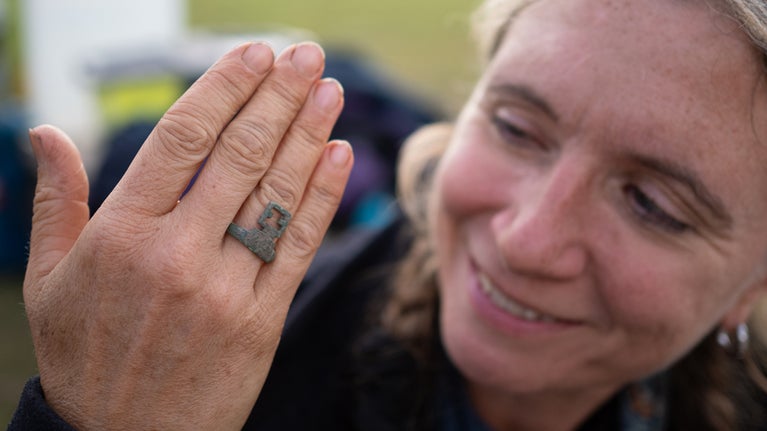Ancient artefacts emerge from recently excavated Roman settlement on the Attingham Estate
- Published:
- 09 October 2025

Following the announcement of a landmark geophysical survey by the National Trust last year – which identified significant archaeological features including Roman villas, cemeteries, roads, and Iron Age farmsteads – recent excavations at one of the sites have uncovered remarkable insights into life on the fringes of Wroxeter Roman City.
Among the most evocative discoveries was part of a 2,000-year-old hand-decorated incense bowl. Found at the heart of what is believed to be a Roman shrine, the piece offers a rare and intimate connection to the spiritual practices of the time.
Over two weeks in September, archaeologists worked alongside volunteers and members of the public to explore three trenches and several test pits. The excavation revealed an Iron Age roundhouse, a Roman industrial complex, and the shrine itself – peeling back centuries of history.
This year, the National Trust launched ‘Attingham Unearthed’, to test a new model for archaeological research. The aim is to create hands-on, sustainable archaeology experiences for the public, alongside experts, with the potential to offer the same at other Trust sites. Attingham was chosen for its rich archaeological landscape, spanning prehistory to the post-medieval period.
Mark Agnew, General Manager of the Attingham Estate, said “This pilot project marks an exciting new approach for the Trust. For the first time, visitors could book a place to dig alongside archaeologists who have been testing the results of the geophysical survey and ensuring our nature recovery ambitions work in harmony with our hidden heritage. The work aims not only to connect people with the past, but also to deepen understanding of the wider history of Attingham Estate.
“What makes this project so innovative is its hands-on, sustainable approach. It transforms traditional excavation into a shared experience that supports research, conservation, and public participation.”
The excavation, on tenanted farmland on the Attingham Estate, unearthed a rich array of artefacts that bring Roman life into the present:
- Piece from an incense bowl – hand decorated and found within a shrine enclosure. This deeply personal artefact points to ritual and remembrance, showing how spiritual life was practiced on the city’s edge and how craftsmanship carried meaning.
- A metal acorn – likely to be a decorative feature from a Roman furniture item such as a small box. In Roman culture, the acorn symbolised fertility, strength, and the origins of life. Its presence suggests domestic comfort and symbolic expression even in utilitarian objects.
- A ceramic object believed to be the base of a candlestick – found within an industrial enclosure, hinting at domestic activity nearby. Its presence suggests that work and home life may have been closely intertwined on the site, and that light and warmth were part of everyday routines.
- A metal helmet handle, surprisingly well preserved, and believed to be part of Roman military gear, offering a tangible link to the soldiers who once occupied the region. Its identification is supported by comparative research, and it may have belonged to a soldier stationed at Wroxeter during the early phases of Roman expansion.
- A Roman coin dating to around 150 BC – predating the Roman occupation of Britain. This striking find may have travelled across Europe with a soldier or trader, offering clues about long-distance movement and personal possessions in the Roman world.
Other investigations prior to the September dig included a supervised, systematic metal detecting survey across all archaeologically significant areas of the estate. Carried out by Newport Heritage Society in partnership with the National Trust, this uncovered a ring key, a clever combination of a piece of jewellery with a working key, often used to secure small boxes or personal items. These objects were both practical and symbolic, reflecting the wearer’s status and their ability to safeguard valuables.
Together, these finds reveal that in both the late Prehistoric and Roman periods, land on the Attingham Estate was a productive, lived-in, worked, and sacred space, connected to wider networks of belief, trade, and military life.
During the excavation, participants, volunteers and Trust archaeologists worked alongside Matt Williams, a Time Team archaeologist, and Dr Roger White, the leading expert on Wroxeter Roman City and its hinterland.
Schools, youth groups, and local community organisations also took part in activities, ranging from surveying and washing finds to guided tours and test pit excavations. The evaluation of the experiences of those that took part is being undertaken by Professor Carenza Lewis, also from Time Team.
Dr Roger White commented: “It is always a great pleasure to work with enthusiastic diggers and to share in the excitement of discovery. This fortnight has made a significant, and important, contribution to our understanding of Wroxeter and its immediate surroundings. The dig may have been small in scale, but its impact is enormous.”
Suzy Watts, National Trust Archaeological Project Manager for ‘Attingham Unearthed’ added: “Attingham Unearthed’ offers a unique chance to explore how ordinary lives played out in the shadow of one of Roman Britain’s great cities. It also shows how archaeology supports wellbeing, from the simple act of being outdoors to the sense of purpose that comes with discovery.
“This has been more than an archaeological excavation. It has been a community collaboration. What we have learned from the people who took part, and what they enjoyed, will shape how we uncover and share hidden histories across other Trust places.”
The objects found during the excavation will be on display to the public in 2026.